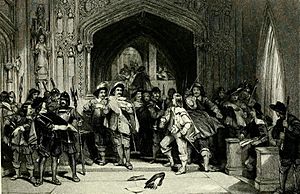Thomas Pride facts for kids
Quick facts for kids
Thomas Pride, appointed Lord Pride under the Protectorate
|
|
|---|---|

Colonel Pride refusing admission to the secluded members of the Long Parliament, December 1648
|
|
| High Sheriff of Surrey | |
| In office 1655–1656 |
|
| Personal details | |
| Born | c. 1606-1608 Ashcott, Somerset |
| Died | 23 October 1658 (aged 52) Worcester Park House, Surrey |
| Nationality | English |
| Spouse | Elizabeth Tomson (1629-his death) |
| Children | Thomas, Joseph, William, Samuel, Elizabeth |
| Residence | Worcester Park House |
| Occupation | Political and religious radical, regicide and Parliamentarian soldier |
| Military service | |
| Years of service | 1642 to 1654 |
| Rank | Colonel |
| Battles/wars | Wars of the Three Kingdoms First Newbury; Lostwithiel; Naseby; Langport; Torrington; Oxford; Preston; Dunbar; Worcester |
Colonel Thomas Pride (who died on October 23, 1658) was an important commander for the Parliament during the Wars of the Three Kingdoms. He is most famous for being one of the people who signed the death warrant for King Charles I and for an event called Pride's Purge.
Contents
Who Was Thomas Pride?
Thomas Pride was born in Ashcott, Somerset, England. His father, William Pride, was a local businessman. We don't know his exact birthday, but he was likely born between 1606 and 1608.
Early Life and Family
In 1629, Thomas Pride married Elizabeth Tomson. She was the daughter of another merchant from London. Thomas and Elizabeth had five children: four sons named Thomas, Joseph, William, and Samuel, and one daughter named Elizabeth.
Thomas Pride started his own business as a brewer. By the early 1640s, he owned two breweries in Surrey and possibly one in Edinburgh, Scotland.
Becoming a Soldier
When the First English Civil War began in 1642, Thomas Pride joined the army. He started as a captain in the New Model Army under Robert Devereux, 3rd Earl of Essex. He was a brave soldier and quickly rose through the ranks to become a colonel.
He showed great courage at the Battle of Preston (1648) in 1648. His army unit then helped take control of London in December 1648. This was a big step towards putting King Charles I on trial.
Pride's Purge and the King's Trial
The army wanted to remove members from the House of Commons who wanted to make peace with King Charles I. This action was planned by the army leaders.
Colonel Pride was chosen to carry out this plan. He stood at the entrance of the House of Commons with a list. He stopped or arrested members who were on his list. After about 100 members were removed, the remaining group, known as the Rump Parliament, decided to put the king on trial. This event is known as Pride's Purge.
Thomas Pride was one of the judges at King Charles I's trial. He also signed the king's death warrant. This made him one of the "regicides," meaning someone who helped cause the death of a king.
Later Life and Achievements
After the king's trial, Colonel Pride continued to serve in the army. He led an infantry group under Oliver Cromwell in important battles like the Battle of Dunbar (1650) and the Battle of Worcester in 1651.
He bought a large estate called Nonsuch Palace in Surrey. In 1655, he became the High Sheriff of Surrey, which was an important local government role.
When the Commonwealth of England was formed, Pride mostly stopped being involved in politics. However, he did speak out against the idea of making Oliver Cromwell a king. In 1656, Cromwell, who was then the Lord Protector, made Thomas Pride a knight.
His Death
Thomas Pride died in 1658 at his home, Worcester Park House, in Surrey. After the monarchy was brought back in 1660 (the Restoration), there were orders to dig up his body and hang it. However, it is believed this order was not carried out, perhaps because his body had decayed too much.

